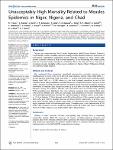Unacceptably High Mortality Related to Measles Epidemics in Niger, Nigeria, and Chad
Grais, R. F.
Dubray, C.
Gerstl, S.
Guthmann, J. P.
Djibo, A.
Nargaye, K. D.
Coker, J.
Alberti, K. P.
Cochet, A.
Ihekweazu, C.
Nathan, N.
Payne, L.
Porten, Klaudia
Sauvageot, D.
Schimmer, B.
Fermon, F.
Burny, M. E.
Hersh, B. S.
Guerin, P. J.
Background: Despite the comprehensive World Health Organization (WHO)/United Nations Children's Fund (UNICEF) measles mortality–reduction strategy and the Measles Initiative, a partnership of international organizations supporting measles mortality reduction in Africa, certain high-burden countries continue to face recurrent epidemics. To our knowledge, few recent studies have documented measles mortality in sub-Saharan Africa. The objective of our study was to investigate measles mortality in three recent epidemics in Niamey (Niger), N'Djamena (Chad), and Adamawa State (Nigeria). Methods and Findings: We conducted three exhaustive household retrospective mortality surveys in one neighbourhood of each of the three affected areas: Boukoki, Niamey, Niger (April 2004, n = 26,795); Moursal, N'Djamena, Chad (June 2005, n = 21,812); and Dong District, Adamawa State, Nigeria (April 2005, n = 16,249), where n is the total surveyed population in each of the respective areas. Study populations included all persons resident for at least 2 wk prior to the study, a duration encompassing the measles incubation period. Heads of households provided information on measles cases, clinical outcomes up to 30 d after rash onset, and health-seeking behaviour during the epidemic. Measles cases and deaths were ascertained using standard WHO surveillance-case definitions. Our main outcome measures were measles attack rates (ARs) and case fatality ratios (CFRs) by age group, and descriptions of measles complications and health-seeking behaviour. Measles ARs were the highest in children under 5 y old (under 5 y): 17.1% in Boukoki, 17.2% in Moursal, and 24.3% in Dong District. CFRs in under 5-y-olds were 4.6%, 4.0%, and 10.8% in Boukoki, Moursal, and Dong District, respectively. In all sites, more than half of measles cases in children aged under 5 y experienced acute respiratory infection and/or diarrhoea in the 30 d following rash onset. Of measles cases, it was reported that 85.7% (979/1,142) of patients visited a health-care facility within 30 d after rash onset in Boukoki, 73.5% (519/706) in Moursal, and 52.8% (603/1,142) in Dong District. Conclusions: Children in these countries still face unacceptably high mortality from a completely preventable disease. While the successes of measles mortality–reduction strategies and progress observed in measles control in other countries of the region are laudable and evident, they should not overshadow the need for intensive efforts in countries that have just begun implementation of the WHO/UNICEF comprehensive strategy.
Dateien zu dieser Publikation
Keine Lizenzangabe
Verwandte Publikationen
Anzeige der Publikationen mit ähnlichem Titel, Autor, Urheber und Thema.
-
2014-04-10ZeitschriftenartikelResults of surveillance for infections with Shiga toxinproducing Escherichia coli (STEC) of serotype O104:H4 after the large outbreak in Germany, July to December 2011 Frank, Christina; Milde-Busch, Astrid; Werber, DirkAfter the massive outbreak of infections with Shiga toxin-producing Escherichia coli (STEC) of serotype O104:H4 in Germany in the summer of 2011, post-outbreak surveillance for further infections with this type of STEC was ...
-
2015-08-27ZeitschriftenartikelTransmission patterns of human enterovirus 71 to, from and among European countries, 2003 to 2013 Hassel, C.; Mirand, A.; Lukashev, A.; Terletskaia-Ladwig, E.; Farkas, A.; Schuffenecker, I.; Diedrich, Sabine; Huemer, H. P.; Archimbaud, C.; Peigue-Lafeuille, H.; Henquell, C.; Bailly, J.Enterovirus 71 (EV-71) is involved in epidemics of hand, foot, and mouth disease (HFMD) and has been reported to occur with severe neurological complications in eastern and south-east Asia. In other geographical areas, the ...
-
2015-06-24ZeitschriftenartikelEbola Virus Disease Outbreak in Isiro, Democratic Republic of the Congo, 2012: Signs and Symptoms, Management and Outcomes Kratz, Thomas; Roddy, Paul; Oloma, Antoine Tshomba; Jeffs, Benjamin; Ciruelo, Diana Pou; Rosa, Olimpia de la; Borchert, MatthiasData collected during the 2012 Ebola virus disease (EVD) epidemic in the Democratic Republic of the Congo were analysed for clinical signs, symptoms and case fatality of EVD caused by Bundibugyo virus (BDBV), establishment ...

